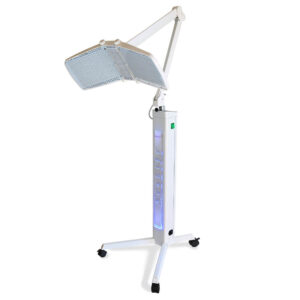By Michelle Gellis AP DiplAc LAc MAc
Introduction to Red Light Therapy

Red light therapy, also known as photobiomodulation or low-level light therapy (LLLT) is a non-invasive procedure that has shown promise in its potential to contribute to the reduction of cellulite by targeting multiple underlying factors.
Cellulite is dimpled skin often found on areas like thighs and buttocks, it is a cosmetic concern for many. Cellulite results from a combination of factors, including genetics, lifestyle, hormones, and the structure of underlying tissues. It’s characterized by the dimpled or lumpy appearance of the skin caused by fat deposits pushing against connective tissues. As collagen fibers lose their elasticity and the skin thins, these fat cells become more visible. While cellulite is a natural occurrence, many seek ways to minimize its appearance for smoother and firmer skin.
Red Light Therapy’s Mechanisms for Cellulite Reduction
Red light therapy involves exposing the skin to specific wavelengths of red light that can penetrate the skin’s surface and interact with cells. This therapy has been studied extensively for its potential to address a range of skin concerns, including the reduction of cellulite. Here’s how red light therapy works to target cellulite:
- Enhanced Blood Flow and Circulation: Red light therapy’s vasodilatory effects help widen blood vessels, leading to improved blood circulation and lymphatic flow. This enhanced circulation aids in the removal of toxins and waste products, potentially reducing the buildup of fluid and inflammation associated with cellulite.
- Stimulation of Collagen Production: Red light therapy is believed to activate fibroblasts, the cells responsible for producing collagen. Collagen is a vital protein that contributes to skin elasticity and firmness. By stimulating collagen production, red light therapy can help improve the overall texture and appearance of the skin, contributing to the reduction of cellulite’s visibility.
- Anti-Inflammatory Effects: Inflammation is often linked to cellulite. Red light therapy’s ability to modulate the immune response and reduce inflammation can lead to a smoother skin surface. By diminishing inflammation, the dimpled appearance caused by swelling and edema can be reduced.
- Potential Fat Cell Shrinkage: Some research suggests that red light therapy might affect fat cells by promoting the release of fatty acids and causing them to shrink. Although the exact mechanisms are not fully understood, this effect could contribute to the reduction of cellulite.
- Cellular Repair and Regeneration: Red light therapy enhances cellular metabolism and repair processes. This can result in improved overall skin health and tissue quality, leading to a reduction in the visible effects of cellulite.
Devices such as the AcuLift AcuLuma LED light are available to acupuncturists and other health professionals for use in the treatment room.
Conclusion
As the pursuit of effective cellulite reduction methods continues, red light therapy emerges as a promising contender. By targeting key factors such as blood circulation, collagen production, inflammation reduction, and even potential fat cell changes, red light therapy offers a multi-faceted approach to addressing cellulite’s appearance.
References:
- https://pubmed.ncbi.nlm.nih.gov/17558758/
- https://pubmed.ncbi.nlm.nih.gov/25597504/
- https://www.ncbi.nlm.nih.gov/pmc/articles/PMC3926176/
- https://www.ncbi.nlm.nih.gov/pmc/articles/PMC3769994/
- Barolet, D. (2009). Ba Regulation of Skin Collagen Metabolism In VitroUsing a Pulsed 660 nm LED Light Source: Clinical Correlation with a Single-Blinded Study, Journal of Investigative Dermatology, 129(12): 2751-2759.
This is a re-post of a blog from our sister site, FacialAcupunctureClasses.com. See the original post here.
